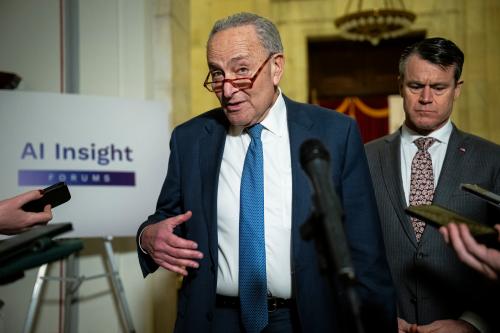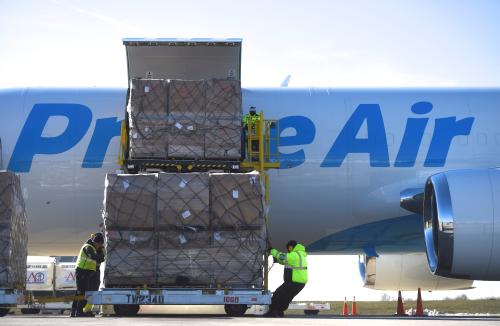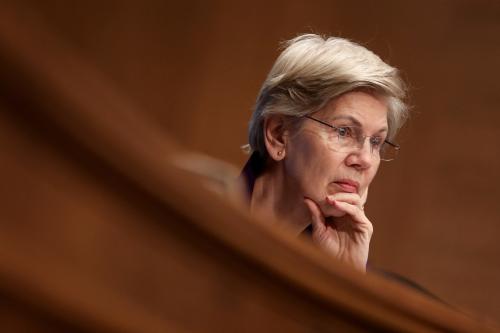In a recent post, antitrust advocate Matt Stoller welcomes “a national discussion to actually build a healthy air grid, and turn away from the deregulation that has brought us so much trouble.” The occasion for his rejoicing is an antitrust court’s rejection of a merger between JetBlue and Spirit Airlines. He welcomes the court’s recognition that the airline industry has become a cozy oligopoly and its refusal to countenance any further consolidation.
But Stoller also thinks a return to price regulation is the answer to the industry’s woes. He argues that the airline industry tends toward overcapacity so that just hoping “competition will win out” is a recipe for “mal-investment, bankruptcies, consolidation, and then mass bailouts.” What we need, he thinks, is a return to the price and route regulatory regime that was rejected in the deregulatory 1970s.
Now the tech industry is very different from the airline industry. But it too tends toward concentration. Huge fixed costs and almost zero marginal costs drive the airline industry’s tendency toward consolidation. Those forces work as well to reduce competition in the core digital industries of search, social media, electronic commerce, and mobile app infrastructure.
But network effects add an extra boost from the demand side toward concentration in digital industries. People love single suppliers in the tech industry. They like one social media company to interact with friends and family, one electronic marketplace where they can find merchants, and one app store where they can download any of the apps that work with the mobile phone they use. Each of the major lines of business in the core digital industries has tipped toward a single or small number of suppliers in part because consumers like it that way.
Price regulation might be part of the regulatory solution to the monopoly abuse and chaos in the airline industry. But how is that relevant to avoiding monopoly abuse in the tech industry, where users get free services in return for company access to their personal information for advertising purposes. In tech, advertisers pay but users don’t. So, price regulation is irrelevant to tech, isn’t it?
Tell that to the app developers who pay 30% of their revenue to Apple and Google as the price of monopoly app store services. In the marginally competitive market for credit card payment services, merchant fees are only 3% to 5%. The oft-repeated claim that 30% represents an industry norm just means that the other monopolist app store does it too.
The truth is that end users are locked into their app store—the only way to switch app stores is to buy a new mobile phone with a different operating system. They have nowhere to go if prices are too high. Developers are locked in too—they would eliminate half their potential customers if they built only for one phone. The stores have monopoly power over both sides of the market.
The 30% cut that app stores take is a disaster for everyone in the market but the app stores themselves. It increases the price for all potential customers and reduces demand below what it would be. A marginal customer might be willing to pay $10 for an app, but at $13—which is what it would cost if app developers raised their prices to cover the app store fee—the app might no longer be worth it to them. To avoid losing that marginal customer, app developers might charge only the $10 that would induce the customer to buy. But that reduces the app developer’s revenue and makes the entire business less rewarding than it would be with a lower app store fee. The result? Fewer new apps from established providers and fewer new app developers to provide innovative products at attractive prices for consumers. With the 30% fee, the app market is smaller, less vibrant, more expensive, and less competitive than it would otherwise be.
If prices were lower and held lower by regulatory action, the owners of the app stores would not be as rich. They just would make a heathy profit from the app store services they supply but not the $85 billion that Apple made worldwide in 2021 or the $10 billion that Google made in 2023. That monopoly profit would flow back to the rest of the industry participants. In the end, consumers and the app developers would all be better off. Consumer prices would go down. Or quality and selection would improve. Or a little of both.
The easiest and best way to reduce app store commission fees is to regulate the price they can charge app developers. How would a regulatory agency set rates? In a normal public utility, it would use cost-plus pricing. So, any attempt to set rates would oblige a regulatory agency to have some understanding of the costs involved in setting up and maintaining an app store, including the needed review of apps to ensure system integrity, privacy, and security. The agency would also have to allow a reasonable return to encourage app store providers to maintain and improve the system.
Perhaps the agency could also use benchmark regulation by looking at prices in comparable industries to see what price seems to cover costs and provide an incentive to maintain and upgrade service. Taxicab companies with a platform business model such as Uber take 25% of the fare for their services. Hotels with a platform business model such as Airbnb take 3% of the room rate, comparable to the credit card charges. Amazon charges an average of 15% of the vendor’s price to the consumer as a “commission” or “referral” fee. Substack, which is only one of many publishing websites, charges writers 10% of any subscription revenue they receive. Alternatives such as the non-profit Ghost charge even less.
Price regulation is an uncertain exercise and intrudes deeply into the business activities of a regulated company. It would be nice to avoid it if possible, and antitrust remedies promise this sort of less intrusive solution to monopoly abuse.
Antitrust remedies short of rate regulation are embodied in court decisions and in proposed legislation, and they could go part of the way toward controlling monopoly pricing in app stores. For instance, allowing app developers to use credit card payment services instead of Apple’s own payment services might allow them to avoid the 30% fee Apple charges.
But the hope that this measure can control prices without further regulatory supervise is vain. App store providers can easily circumvent this restriction. Under a recent California court decision, which the Supreme Court declined to review, Apple must allow developers to use an alternative payment system. It is preparing to comply with this requirement by charging developers who use alternative payments a 27% service fee, which effectively mirrors the 30% fee it collected when it required the use of its own payment services.
Developers can challenge that practice as inconsistent with the intent of the court ruling. But now, however, the court has effectively been put in the position of a price regulator determining whether 27% is too high a price for developers to pay.
Other antitrust proceedings have not gotten to the remedy stage. At the end of 2023, a jury handed developer Epic Games a huge win in its antitrust case against Google over its Play store practices and pricing, including a finding of maintaining a monopoly. But the court is only now considering a remedy. The U.S. Department of Justice’s Antitrust Division is preparing a new case against Apple, apparently alleging that its control over the app store allows it to engage in various anticompetitive abuses. Once they get to the stage of trying to devise a remedy, the antitrust authorities and the courts will face the same dilemma of trying to find a self-enforcing constraint that does not require regulatory price supervision.
European competition authorities have always been able to exercise greater regulatory controls over companies that have violated their competition laws, and this capacity has been ramped up dramatically with the coming into effect of its Digital Markets Act (DMA). This new law allows the European Commission to designate certain digital companies as “gatekeepers,” thereby triggering a range of regulatory prohibitions and mandates. The Commission has designated both Google and Apple as gatekeepers with respect to their app store operations, although Apple is challenging that decision. This designation comes with a ban on “requiring app developers to use certain of the gatekeeper’s services (such as payment systems or identity providers).”
The application of DMA might also force Apple and Google to allow end users to install third-party app stores that “interoperate” with their mobile operating systems. This could allow developers to sell their apps outside of the monopoly app stores, thereby providing some price competition for these stores. Perhaps this competition will force prices down.
But allowing developers unfettered access to mobile operating systems and browsers without any supervision by the provider of these network services is a recipe for security disasters and operational chaos. The app stores have properly argued against uncontrolled side-loading that would allow users to download mobile apps directly from websites rather than from approved stores. Regulatory mandates for interoperability must allow the system operator substantial discretion over which apps can be allowed onto the system. They must also provide the operator an opportunity to recoup its costs by charging for this system maintenance service, costs they were able to recover earlier by bundling them with their app store commission.
But concern about operational integrity, privacy and security issues should not give the app stores carte blanche to do whatever they want, while waving the flag of protecting the system’s integrity and stability. Like it or not, if the European Commission goes down this road of interoperating app stores, it will need to exercise regulatory supervision to make sure that, under the guise of protecting privacy, security, and system integrity, the app stores are not in fact extracting monopoly profits. A recent review of Apple’s proposed compliance with new regulations under DMA found such serious obstacles to genuine alternatives for app developers that it urged the European Commission to “open infringement proceedings on 7 March 2024.”
It might be best to start with an interoperability requirement for app stores. Such a measure might bring the forces of competition to bear on app developer prices. If it doesn’t work, regulators can always move on to a pure price regulation regime. But app store interoperability is not a way around supervisory and price regulation. To make it work, regulators will have to closely monitor app store practices to ensure their prices are in line with the essential services they supply.
Self-enforcing antitrust remedies, such as a one-time ruling that app stores must permit app developers to use their own payment systems, will not do the job of controlling monopoly pricing power. Ongoing regulatory supervision is needed to enforce such rules. How well the Commission fulfills its pro-competitive regulatory role under the Digital Markets Act is yet to be seen.
But in the United States, such a regulatory role simply cannot be carried out by generalist antitrust authorities and courts. Creating the framework to supervise app stores and the mobile app infrastructure of browsers and operating systems requires substantial institutional innovation. As I argue in my book, “Regulating Digital Industries,” promoting competition and protecting captive users from monopoly abuses in digital industries requires a dedicated industry regulator. Since so many of these competition issues overlap with the protection of privacy and the prevention of information disorder, I also argue that a digital regulator would have to have responsibility over the privacy and content moderation practices of companies in core digital industries.
The mobile app infrastructure consisting of the interrelated complex of mobile browsers, operating systems, and app stores is a core digital industry. It is central to the successful operation of a large range of enterprises and to the conduct of personal, social, and political life in the 21st century. It is also a market where competitive forces have manifestly failed to protect the public interest. It needs to be under the public supervision of a digital industry regulator.
In a reference to Winston Churchill in his post cited above, Matt Stoller sees “the end of the beginning” of price regulation’s return for airlines. But price regulation in all but name is already a reality in some digital industries under the guise of privacy regulation. California’s privacy regulators must rule on the acceptability of a company’s “financial incentives” for the sharing or sale of personal data, including whether an offered difference in price or service is “reasonably related to the value of the consumer’s data.” European data protection authorities must soon decide if Meta has set an “appropriate” fee of €9.99/month on the web or €12.99/month on iOS and Android for subscription to Instagram and Facebook without ads.
A dedicated industry regulator would make the job of regulating these prices and enforcing other pro-competitive rules much more effective and would create an administrative structure to balance the sometimes-conflicting demands of competition, privacy, and online safety.
In the past, these ideas of regulatory supervision would be dismissed as the left-over legacy of discredited public utility thinking, unfit for a fast-moving tech industry whose motto has always been to move fast and break things. But the 40-year-old era of deregulation and letting even monopoly industries govern themselves is fading. It is time to apply this renewed regulatory thinking, including the need for price regulation, more broadly to digital industries.
-
Acknowledgements and disclosures
Google and Amazon are general, unrestricted donors to the Brookings Institution. The findings, interpretations, and conclusions posted in this piece are solely those of the author and are not influenced by any donation.







Commentary
Mobile app stores may need price regulation
February 1, 2024